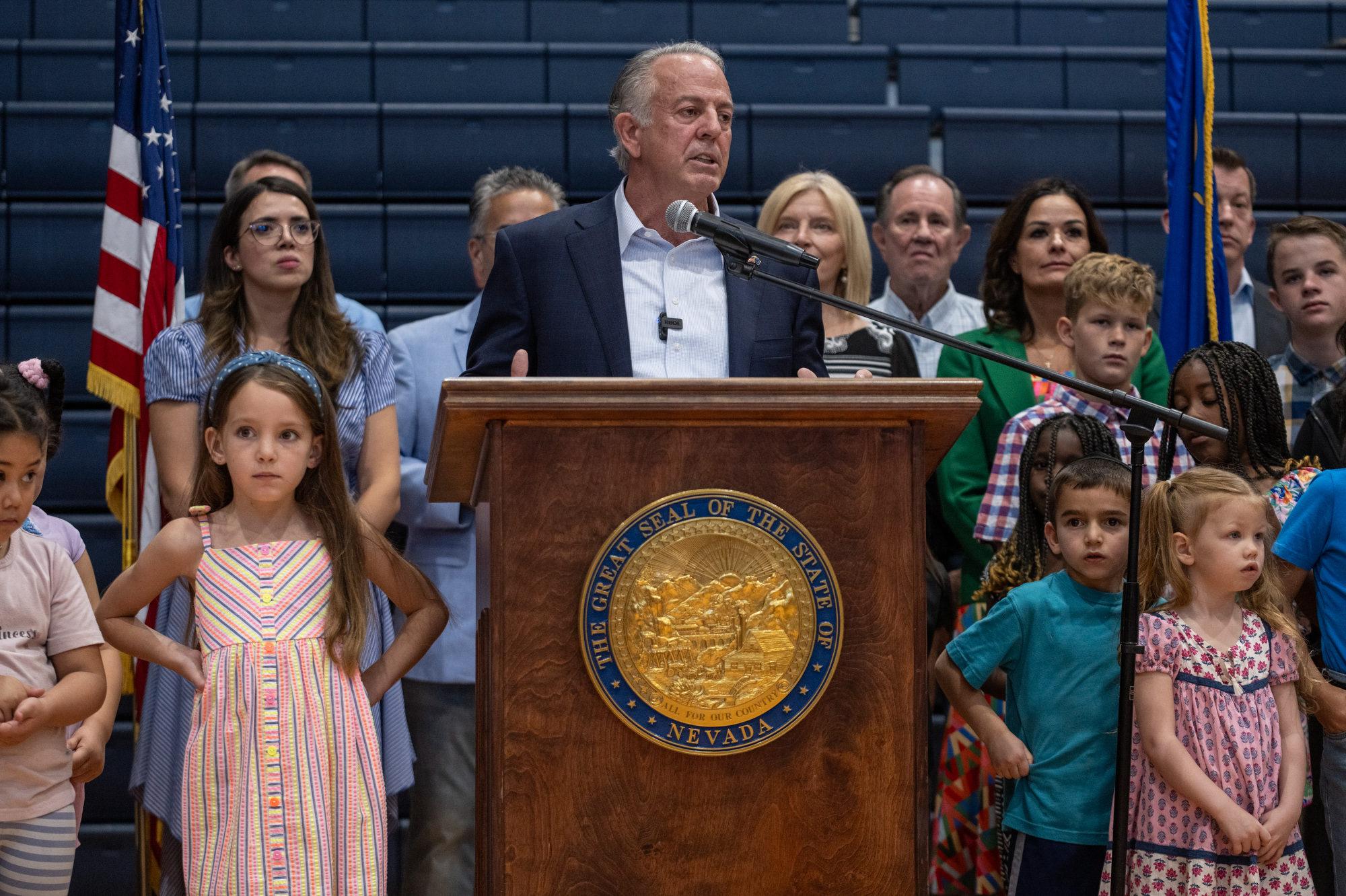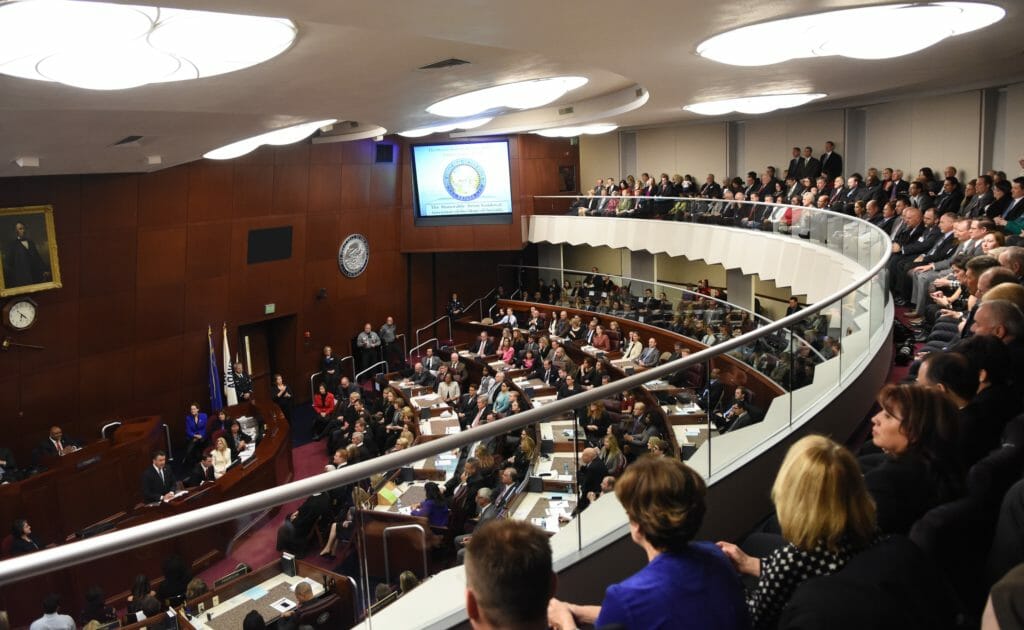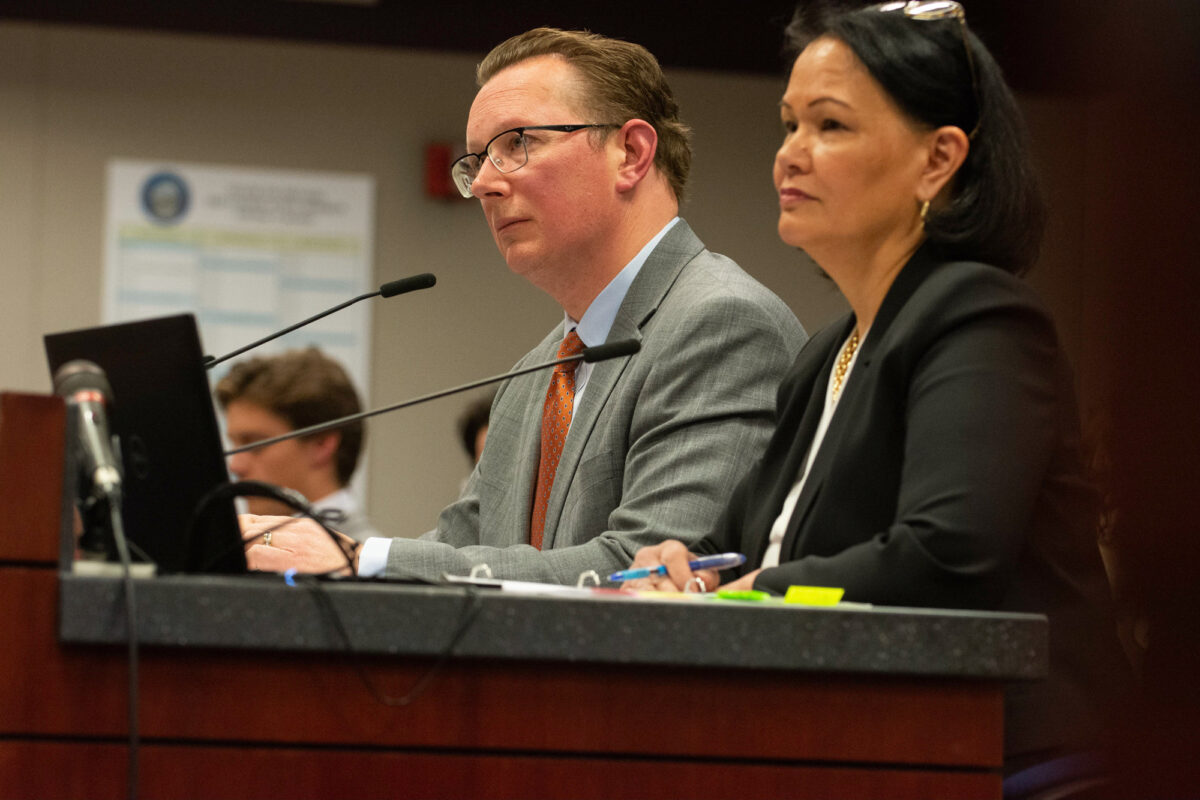The Indy Explains: How Opportunity Scholarships became a political flashpoint

Rallying inside a Las Vegas gymnasium last week — surrounded by private school advocates, lawmakers and even several dozen children attending local private schools — Republican Gov. Joe Lombardo had a message for the media.
Reports of his school choice agenda’s demise had been greatly exaggerated.
“My administration has been fighting for school choice and Opportunity Scholarships since the day I took office — since the day I took office, okay?” Lombardo said Friday. “I know there's been press releases here in the last few days that say that we folded the negotiations, and there can't be anything further from the truth.”
In the last eight years, those Opportunity Scholarships, a needs-based scholarship program for low- and certain middle-income families to attend private or religious schools, have become a reliable political football, kicked up every two years as its funding mechanism again becomes one of many chips in eleventh-hour legislative negotiations.
But Lombardo’s remarks came two months after the 2023 legislative session had ended, and two months after legislative Democrats, who control a supermajority in one house and fall just one seat shy in the other, had gutted a proposal from his office to greatly expand the program.
At the time, Democrats argued Lombardo’s proposal — which, in its original form, would have boosted Opportunity Scholarship funding levels from about $13 million every two years to roughly $500 million by 2032 — was far too expansive, a “huge, huge amount” that served as little more than vouchers for private schools.
Republicans, who created the program in 2015, have countered that the scholarship applications are means-tested, and that the new money would only come after a historic $2 billion infusion of new state dollars in the public K-12 budget.
But amid a budget stalemate that led to the first partial budget veto in more than a decade, the proposal was stripped away from the governor’s K-12 omnibus bill in a trade that saw the full K-12 budget signed later that night.
Lombardo and the organizations running the scholarship programs say the decision has left them in the lurch, potentially threatening more than half of all students in the scholarship program after tax credits were granted only to some organizations — those that were physically first in line for the limited pot of resources when applications were opened.
On Wednesday, lawmakers on the Interim Finance Committee, also controlled by Democrats, will weigh a Lombardo proposal allotting $3.2 million in federal COVID relief aid to prevent just such a purge.
Even still, Democrats have signaled skepticism of the underlying financials, asking scholarship organizations to prove they are poised to lose students and raising hackles that, last year, scholarship organizations raised $3.8 million more for scholarships than they awarded.
So — how did we get here?
What are Opportunity Scholarships and how do they work?
In simple terms, Opportunity Scholarships — formally the Nevada Educational Choice Scholarship Program — subsidize tuition at Nevada private schools, including religious schools.
Families only qualify for the scholarships if they are at or below 300 percent of the federal poverty line, which is $90,000 for a family of four in 2023. The most recent state reporting shows families of recipients generally make substantially less than the cap — roughly $52,100 on average — though reporting requirements only provide average income and award levels.
Opportunity Scholarships do not directly receive state dollars, unlike other state scholarship programs such as the Millennium Scholarship for college students (which is funded through a state trust fund).
Instead, the scholarships are funded by donations from businesses made out to scholarship grant organizations (SGOs), third party organizations tasked with distributing the scholarships. Those businesses in turn receive a one-to-one amount of tax credits from the state that can be used against the state’s modified business tax (MBT), also known as the payroll tax.
Are SGOs ‘missing’ money?
Once SGOs receive donations, they are legally allowed to carry that money forward for up to five years from when the contribution was made. SGO leaders told The Nevada Independent that the arrangement allows flexibility for students to continue receiving scholarships even if contributions (or the political landscape) change.
Because those contributions can be held for years — and because SGOs are allowed to retain up to 5 percent of donations for internal operations — the amount of tax credits handed out by the state may not line up with the amount of scholarships awarded in a given year, especially as the cap on tax credits has pinballed down and up and down again since 2019.
For instance, AAA Scholarship Foundation, the largest of the six approved and active SGOs, reported $7.6 million in contributions, but only $5.5 million in scholarships awarded, according to numbers filed for the 2022-23 school year.
Last week, Democrats criticized the transparency of those carry-forward dollars, describing in a press release the difference between contributions in and scholarships out as “missing” money. Asked about the difference by reporters Friday, Lombardo called it “transition” funding, still encumbered for students who may start in the program but later leave.

However, the report compiled annually by the Nevada Department of Education (NDE) is published only at the end of the calendar year — the middle of any given school year — and does not include how much money each SGO has carried over.
The maximum scholarship amount is tied to inflation and set by the state education department, with the 2023-2024 school year maximum topping out at $9,424 — though the actual amounts awarded often fall well below that cap. Students can submit applications to multiple SGOs as long as the total amount awarded doesn’t exceed $9,424 — a $698 increase from the previous school year.
The scholarship can be applied toward tuition, fees, and transportation costs associated with attending the private school. How much each private school receives through how many students can vary widely.
Las Vegas’ Desert Torah Academy, for instance, was awarded more than $802,000 in scholarships for 139 students in 2022, with the vast majority — 120 students with $707,000 in scholarships — coming from one SGO, Silver State Scholarships. Just below was Awaken Christian Academy, another Las Vegas school awarded more than $637,000 from 110 students across four separate SGOs.
According to NDE’s most recent report from last year, 1,402 students received a scholarship, with 173 of those students receiving more than one scholarship. Caucasian students make up the largest percentage of awardees, at 38 percent, followed by Hispanic students, at 26 percent.
How did we get here?
Opportunity Scholarships were created under a Republican state government trifecta in 2015, passing without a single Democratic vote in the Legislature.
It was a measure that came only after a similar effort faltered in 2013 — when Democrats still controlled both legislative chambers — and one that spent years largely overshadowed by another, more expansive 2015 program, Education Savings Accounts, which consumed the political capital available for school choice amid years of courtroom battles and budget negotiations.
As written, the 2015 bill (AB165) provided $5 million for such scholarships in the first fiscal year and $5.5 million in the next, with a built-in “escalator” that would slowly ramp up the cap on available tax credits by 10 percent every year.
Speaking during an initial bill hearing in 2015, Gov. Brian Sandoval’s then-deputy chief of staff, Chris Nielsen, told the Assembly Education Committee that the program was among the Republican governor’s “key priorities” in his broader education package.
“For the first time, it'll give certain children the option or choice to attend private schools without having to worry about paying for the high cost of tuition,” Nielsen said.
Two years later, legislative Democrats (now in the majority after flipping control of both legislative chambers) moved to quash funding for the much broader ESAs program, but as part of a compromise deal with Republican Gov. Brian Sandoval agreed to boost Opportunity Scholarships with a one-time injection of $20 million in 2017.

Ever since, Democrats have sought to starve the program. After winning control of the Legislature and the governor’s office in the 2018 midterm elections, Democrats introduced legislation to freeze the cap at just over $6.6 million, as well as ax the 10 percent growth escalator.
Democrats argued the growth provision was “unsustainable,” with then-Assembly Speaker Jason Frierson (D-Las Vegas) arguing at the time that the escalator would be “out of control in a short amount of time.”
For comparison, had the total available tax credits continued to increase by 10 percent, it would have hit more than $17.2 million annually by 2029.
The 2019 bill passed, this time without a single Republican vote — though lawmakers in another last-minute compromise added an extra $9.4 million in one-time funds for the biennium — pushing total yearly tax credits to around $11.3 million — all aimed at preventing an exodus of students.
In 2021, as part of a deal significantly expanding mining taxes to boost public K-12 spending, Democrats secured key GOP votes by promising a new one-time injection of more than $4.7 million to Opportunity Scholarships.
That effectively kept funding levels flat, extending the 2019 compromise deal one more fiscal year through the end of fiscal year 2021-2022.
Then came a new governor.
The push to expand
In his own State of the State address, Lombardo — the state’s first GOP governor since Sandoval — planted a flag on Opportunity Scholarships, marking the program as the centerpiece of his effort to expand school choice policies under the Democrat-controlled Legislature.
“Traditional public schools are not — and should not — be the only option,” he said, even as he touted a coming $2 billion spending increase for public K-12 schools.
Envisioned as part of his education omnibus bill, AB400, Lombardo’s plan would have immediately increased the tax credit cap from $6.6 million to around $25 million annually by tying the total funding for Opportunity Scholarships to an increasing percentage of the state’s K-12 budget. That percentage would stop increasing in 2032 — after the cap was to hit an estimated $500 million, according to a bill presentation at the time from Lombardo Chief of Staff Ben Kieckhefer.

Separately, the bill also proposed increasing the eligibility requirements from 300 percent of the poverty line to 500 percent, the difference between $90,000 under the existing cap and $150,000 under the new levels for a family of four.
The proposals were a non-starter for legislative Democrats, who still controlled a supermajority in the Assembly and were just one seat short of that in the Senate. In press conferences and interviews, Democratic leaders balked at the scale of the increase, instead arguing that leaving funding flat at $6.6 million — and not zeroing out the program altogether — was their compromise position.
More than that, some Democrats argued a conversation about funding school choice programs could not come before the state completed a 10-year plan to boost public K-12 funding levels recommended by the state’s Commission on School Funding.
“You're asking us to make the choice to take the state's money, the tax revenue, and not put it into the public education system that we all agree is underfunded, and even in the best of circumstances is probably going to take another five years to get there,” Assembly Speaker Steve Yeager said during an initial hearing on AB400 in May.
As the end of the session spiraled into a budget showdown, the Opportunity Scholarship push fell by the wayside. Ahead of a deal to sign the K-12 budget into law, Democrats amended AB400, removing large swaths of the language in a deal that preserved several new charter school policies instead.
In the final hours of the session, AB400 finally sailed through the Democrat-led Legislature — though only as part of a broader deal to advance Lombardo's major policy bills in exchange for signing the state’s multiple budget bills.
Last month, the pro-Lombardo Better Nevada PAC began criticizing legislative Democrats over the move on social media, accusing lawmakers of “defunding” Opportunity Scholarships and putting the continued enrollment of hundreds of students at risk.
In late July, Lombardo announced a new emergency measure — the $3.2 million in federal COVID aid money that could be funneled to SGOs, should lawmakers on the Interim Finance Committee approve the move during a meeting Wednesday.
Top party leaders have since engaged in a war of words.
Last Wednesday, Democratic lawmakers in Las Vegas held a news conference in which they charged that the governor’s team had never raised the issue of continuing the one-time dollars from 2021 as a means to prevent students from losing existing scholarships.
“It was never our intent that anybody in the program would lose their place due to lack of funding,” Yeager said. “It was not an issue that anybody raised during the legislative session.”
Two days later, Lombardo — for the second time this year — took to the lectern to rally school choice advocates at a Las Vegas private school.
“I use the word potentially, as a matter of the written word, but actually, it’s a reality,” Lombardo said. “If we’re not able to supplement Opportunity Scholarships … there will be hundreds of scholarships removed … That is unacceptable to me.”

